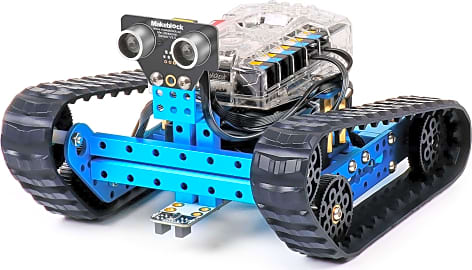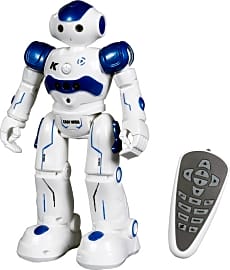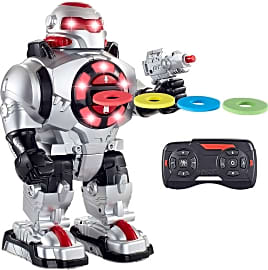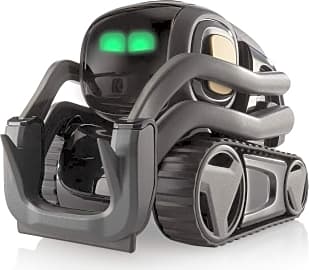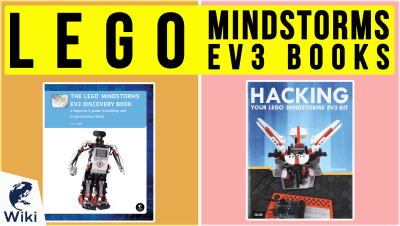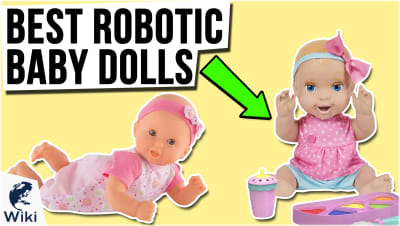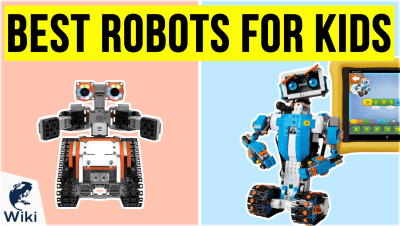The 10 Best Personal Robots

This wiki has been updated 39 times since it was first published in August of 2016. We're not saying that machines are going to take over the world, but it may be a good idea to hedge your bets by investing in one of these interactive personal robots. From offering help around the house to teaching children about coding and engineering, the bots on our list are both functional and fun. Some come with a lot of small pieces though, so it's important to consider the age of the user. When users buy our independently chosen editorial picks, we may earn commissions to help fund the Wiki.
Editor's Notes
December 14, 2020:
As the march of progress continues on, both robotics and the demands of the world around us continue to evolve. This update reflects that shifting landscape.
During this round, we said goodbye to a few different items, simply because other products offered more distinct benefits. The Meccano Micronoid Code Zapp, for instance, despite a rather affordable price, had rather limited functionality relative to other bots in the same price range. Others, like the Lego Mindstorms EV3, despite presenting a versatile range of activities, had too high a price tag relative to its value to justify its inclusion.
In other cases, items were swapped out because of availability concerns. The Ozobot Evo was no longer available with no reintroduction date in sight. In still other cases, newer models had been introduced and the availability of older models had become limited. For example, the Anki Vector didn’t necessarily offer significant improvements over the Anki Cozmo, but the Cozmo was much harder to track down.
While the Sphero Sprk + Steam suffers from the same availability issues, there is a mini version available. The company, however, has since introduced the Sphero RVR, which arguably provides an even broader range of learning activities. Sphero’s R2-D2 bot, on the other hand, was replaced by the Littlebits Star Wars Droid. Though similar in shape, it also offers more activities for young learners.
The Think Gizmos RoboShooter and Sgile RC are newcomers to the list, earning their spot thanks to consistently positive reviews, their engaging humanoid forms, and the depth of learning opportunities they provide.
Sillibird STEM 12-in-1 is also new to the list but makes an impression. Though similar to the Lego Mindstorms EV3 in some ways, its clear instructions, incorporation of new technology, extensive customization opportunities, and far more affordable price made it more appealing.
It’s important to remember that nearly all personal robots come with a huge amount of tiny pieces, presenting a choking hazard to your tiniest tots. Before making a selection, you should consider the ages of the children in your home and the manufacturer’s age recommendations. If you do have young ones you’re worried about but are still interested in finding an animatronic gift, it might be worth it to check out an age-appropriate robotic baby doll or one of the cuddlier robotic pets on the market.
December 17, 2019:
Personal robots strike a perfect balance between being an educational item and a fun toy. They help youngsters learn basic coding skills and, because they are programmable, provide endless hours of entertainment.
During this update, we eliminated the Jibo 2 because it doesn't really offer anything more than Amazon's Alexa, and even it even performs most of those overlapping actions poorly. Additionally, we removed the Ubtech Lynx because it is very overpriced for its limited functionality, especially when compared to some of the other bots on this list.
Making its debut this year is the Meccano Meccanoid XL 2.0 Erector, which stands as tall as the average seven-year-old. While it is challenging to build, comprised of more than 1,000 parts, those who can complete it will get a lot of satisfaction out of a job well done. Also, once it is fully built and ready to go, it can be programmed with a near limitless number of actions.
The Makeblock mBot Ranger is another new addition that we like for its simple assembly and compatibility with Legos and other building block toys. As you might guess by the name, the Lego Mindstorms EV3 is also compatible with many Lego sets. With the ability to support a variety of coding languages, this droid is a great way to introduce children to multiple programming syntax, after which they can pursue the one they like the most. To really get the most out of it though, we recommend buying a few Mindstorms EV3 books.
If you are looking for something slightly more affordable, and perhaps less advanced than the Mindstorms EV3, you may want to check out the Lego Boost Creative Toolbox, which will be easier for younger children, yet still offers a good amount of functionality. Steeping down considerably further in cost and functionality we have the Meccano Micronoid Code Zapp. Though it definitely falls firmly into the toy category, it does teach very basic programming skills.
Special Honors
Lovot If you want the emotional connection of a pet, but aren't allowed to have one in your home or simply don't have the time for one, Lovlot may be the answer. Unlike many other personal robots that can be given tasks, this one simply follows you around your home and wants to be loved, which includes promoting you to pet, hug, and play with it. lovot.life
Nao Power V6 Comprised of a multitude of sensors, cameras, and motors, and running on a custom made operating system, the Nao Power V6 is definitely not a toy. It can be programmed for full autonomy using Drag&Drop, C++, Python, or Java and boasts Bluetooth and Wi-Fi connectivity. However, it is extremely expensive and best for educational and commercial facilities. robotlab.com
A Brief History Of Botting
Nowhere are the complexities of human interactions with the technologies we develop more evident than in the field of robotics.
Nowhere are the complexities of human interactions with the technologies we develop more evident than in the field of robotics. In the inexorable march of progress, the notion of a mechanized version of ourselves falling into step alongside us — with the potential to surpass us in ways we can only begin to imagine — generates both ecstatic hope and paroxysmal anxiety. Even in its earliest iterations, the term robot, arising from a Czech word meaning “forced labor”, carried some heavy baggage.
Although the modern concept of robotics traces its roots back a mere hundred years or so, representations of manufactured beings and fabricated automata appear throughout the pages of recorded history. Among the oldest known automatons are the mythological statue of Pygmalion and a clockwork dove designed by Archytas of Tarentum around 350 B.C.E., which is described as having flown as far as 200 meters. And long before the chess-playing hoax known as the Turk created a furore in the Viennese court, the mechanical monk commissioned by 16th-century Spanish monarch Phillip II was demonstrating the proper sequence of religious devotions.
In the modern era, industrial machines have fomented discord on factory floors, giving rise to union calls to prevent the loss of blue-collar workers' livelihoods. And at the dawn of the new millennium, automated systems seem poised to supplant or render obsolete an astonishing repertoire of human accomplishments. No longer confined to the realm of fantasy and science fiction, robotic creations are so intimately woven into the fabric of our lives that we think nothing of giving them cutesy names and entrusting them with aspects of our children's social development.
Celluloid Droids And Crises Of Conscience
Proclamations from the greatest minds in science and technology have raised not only our hopes for the future of robotics (think airborne fleets of self-driving vehicles), but also the disturbing spectre of AI and machine-learning run amok. While soft robotics may offer the promise of benign and infinitely patient inflatables like Baymax (the huggable “personal healthcare assistant” of Disney’s Big Hero 6), we can't ignore the scarier products of our imaginations like those that terrorize — and radically alter the fortunes of — the Aliens and Terminator franchises' protagonists, or the characters' troubling predicaments in such films as Her and Ex Machina.
As fraught as it is storied, the cinematic journey of robots — from the clunky artifice of Robby the Robot and the mindlessly menacing Cybermen of Dr. Who infamy to the touching, aspirational humanity of A.I.'s David and android Andrew Martin in Bicentennial Man — offers intriguing insights into human nature and the ways we engage with technology. Watching these fictional dilemmas and existential crises play out is a profoundly uncomfortable experience because it's impossible not to feel empathy for both the humans and the anthropomorphic machines that (who?) share the screen with them.
Perhaps even more unsettling are the enigmatic Synths of AMC’s Humans and the robotic Hosts of HBO’s Westworld series, which (who?) leave us grappling with the very crux of our existence. What does it mean to be sentient, how do we define consciousness, and is the term artificial intelligence itself nothing more than an egocentric social construct? Should we be talking instead about alternative or applied intelligence? Whether they’re wiping our tears and fighting for justice or waging cybernetic warfare to wipe the human stain from our planet, these on-screen portrayals of humanoid robots touch at the heart of the human condition.
Gyros And Servos And Actuators, Oh My!
In spite of the extraordinary progress we've already made toward bringing something like Isaac Asimov's positronic brain to life, as it were, the road ahead is a treacherous one — littered with innumerable ethical quandaries, ideological issues, and unforeseen consequences. But for the glass-half-full crowd, there's plenty of cause for optimism. Recent developments in neural networks offer the promise of touch-sensitive prosthetics, which could significantly improve quality of life for amputees and paralytics, not to mention making mundane tasks like stirring sauces and stacking boxes a lot less odious.
Young children can now learn the basics of coding through interactions with programmable robot toys, and new applications for home automations and the so-called Internet of Things emerge on a daily basis. Computer-operated devices are now responsible for a dizzying assortment of mundane and repetitive tasks. They're patrolling and tidying our floors, sucking up detritus from our suburban swimming pools, simplifying meal preparation, and teaching communication skills. We're even invited to take the idea of embracing technology quite literally — snuggling up to it to help us sleep. What were once fantastical luxuries for the wealthy and privileged are increasingly accessible to the middle class.
While the apparent suicidal tendencies of a security droid may raise some worrisome questions, and living cogs in the industrial machine get understandably fidgety at the prospect of losing their jobs to actual drones, there’s no denying the appeal of a world in which package delivery doesn’t depend entirely on armies of living carriers braving snow, rain, heat and dark of night in the swift completion of their appointed rounds.



